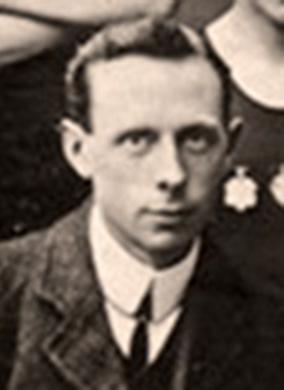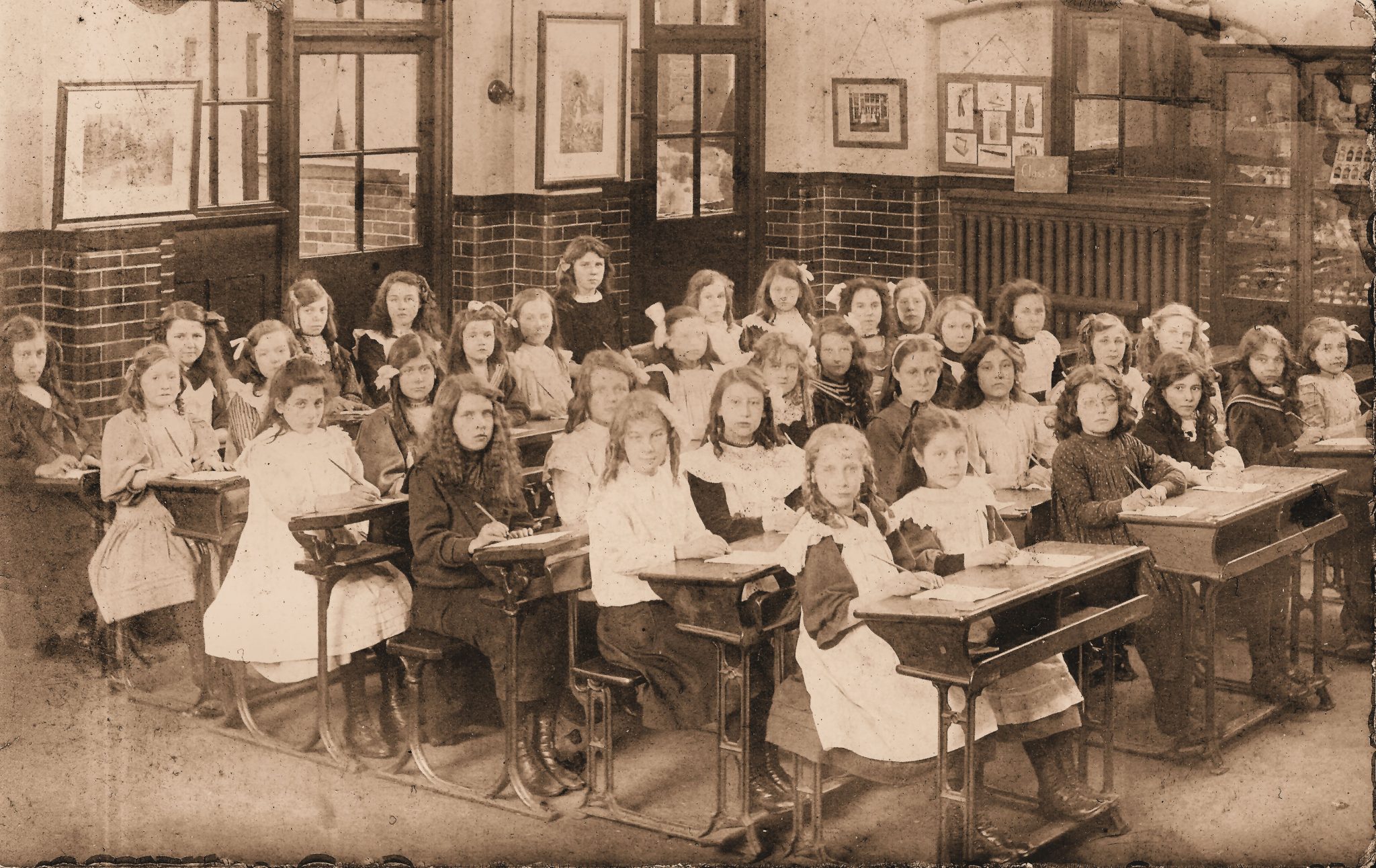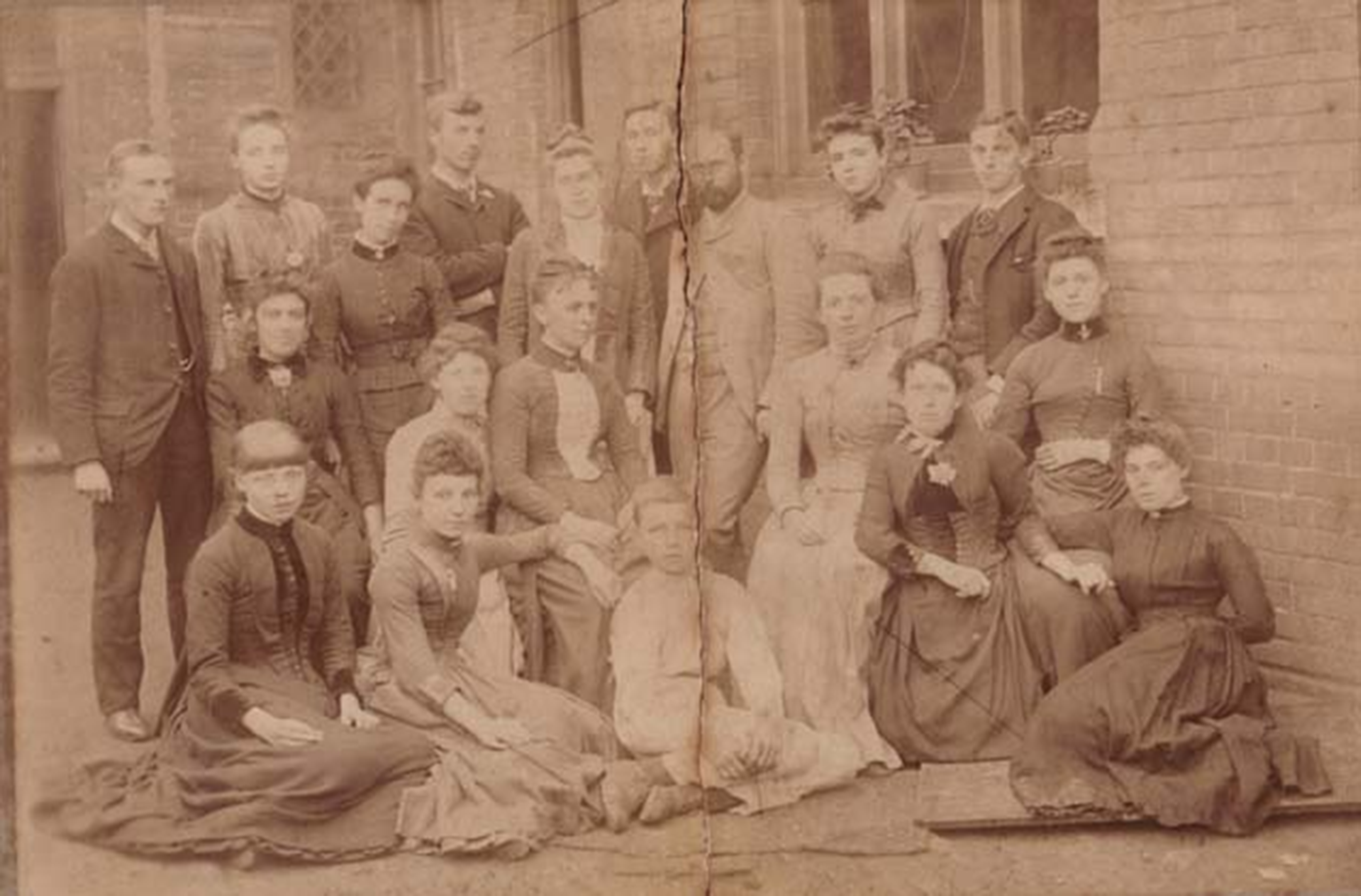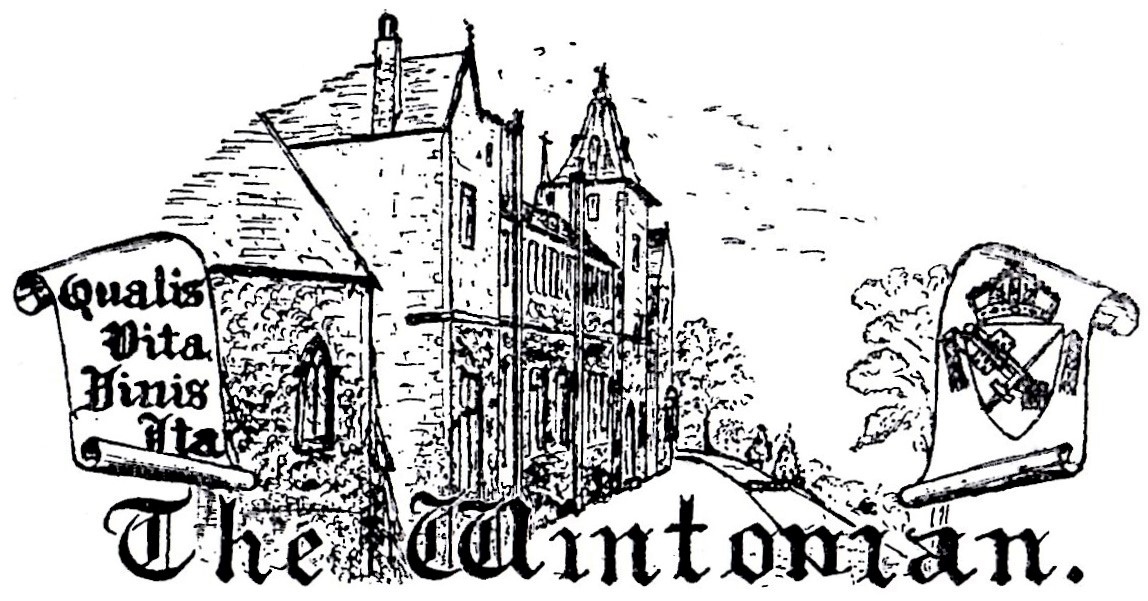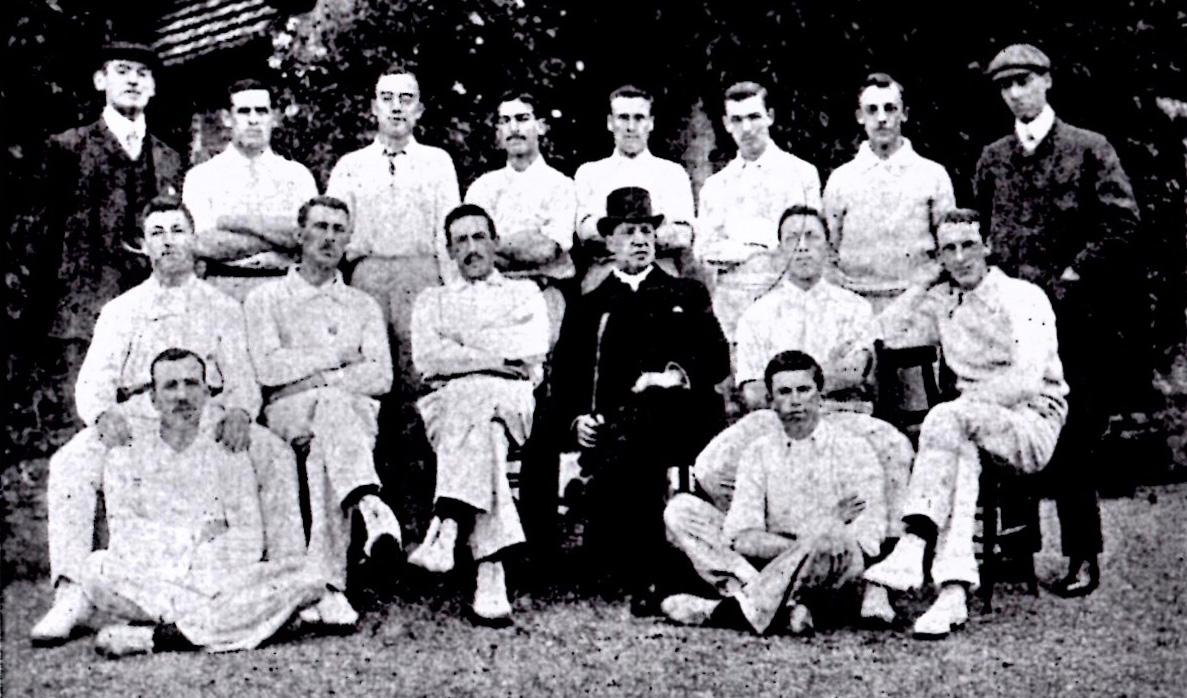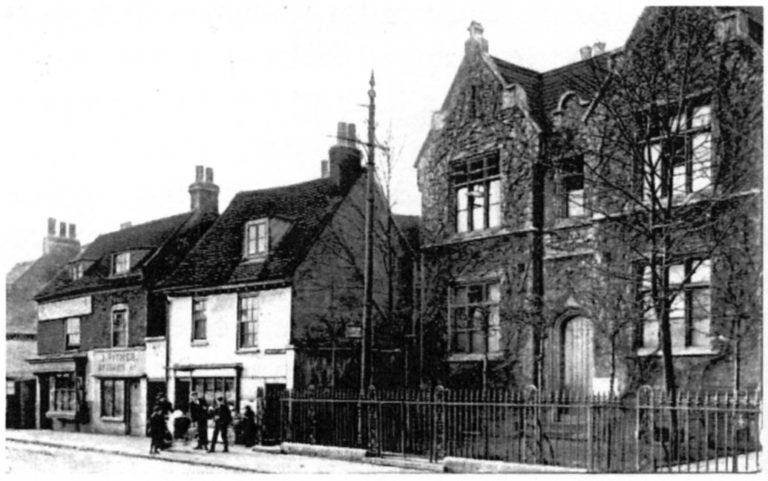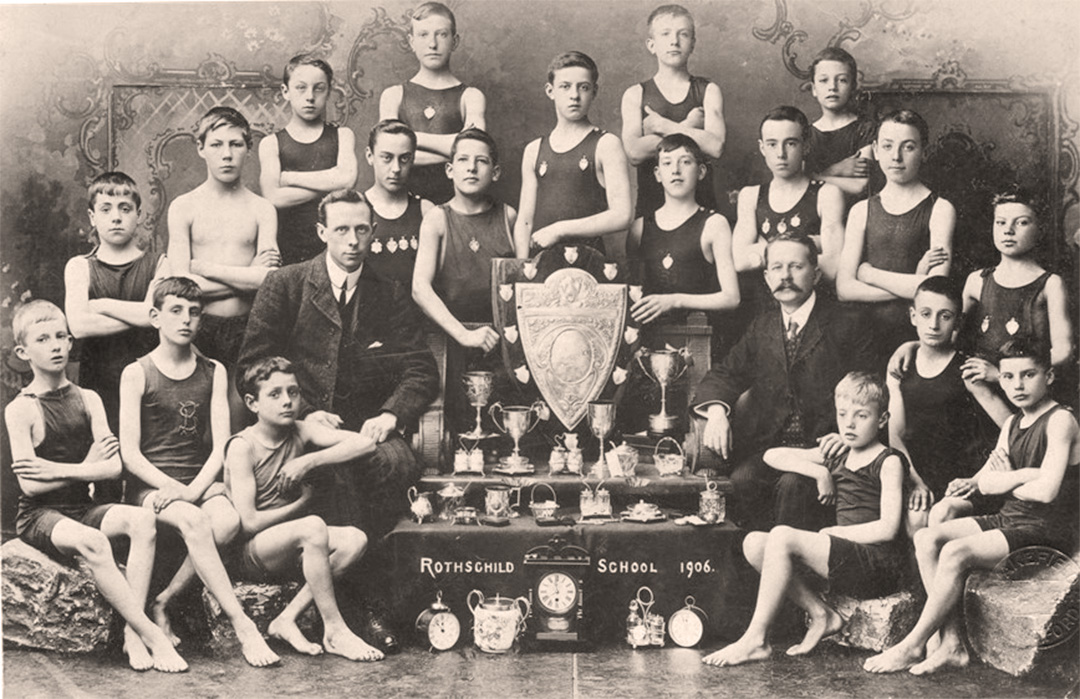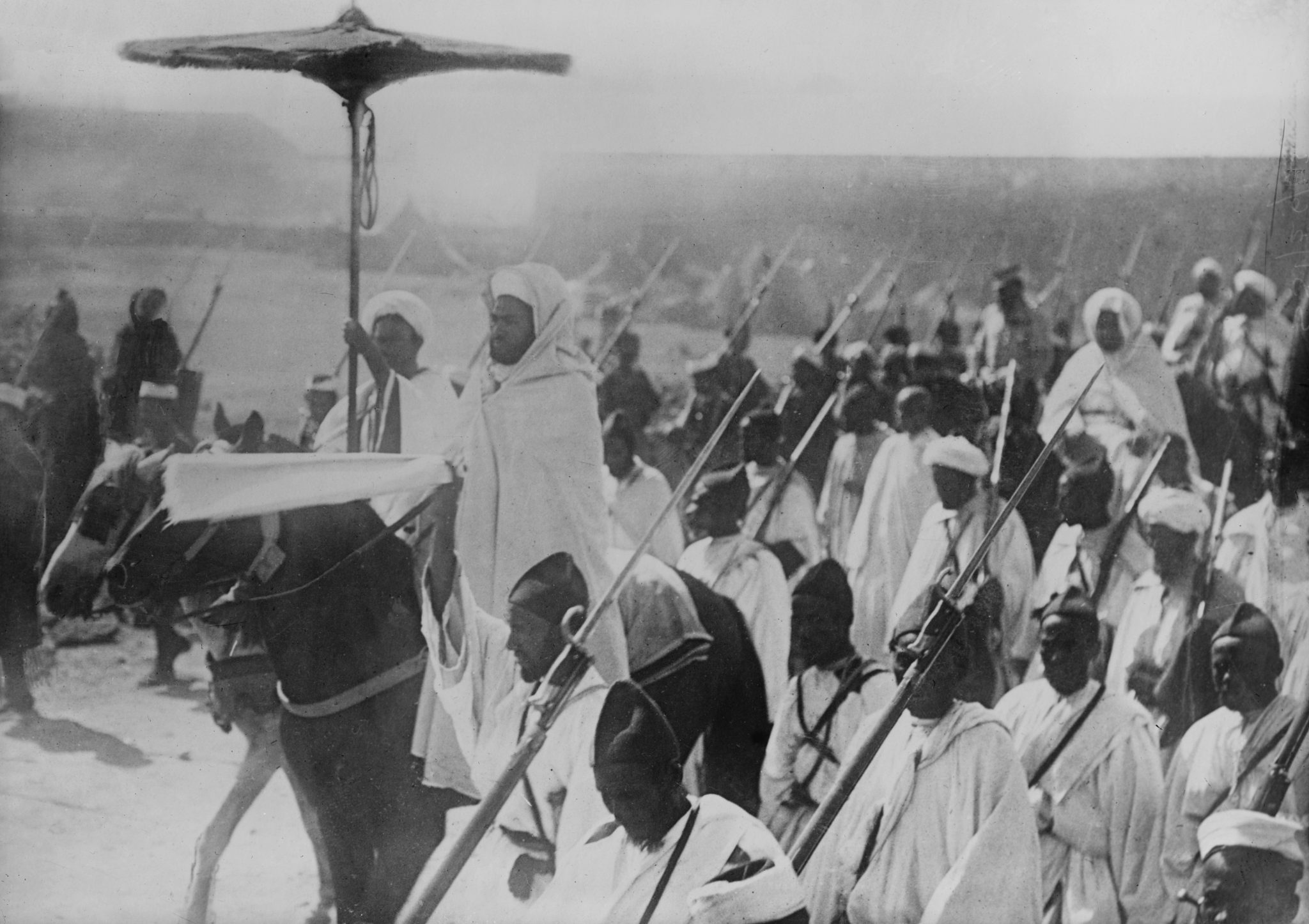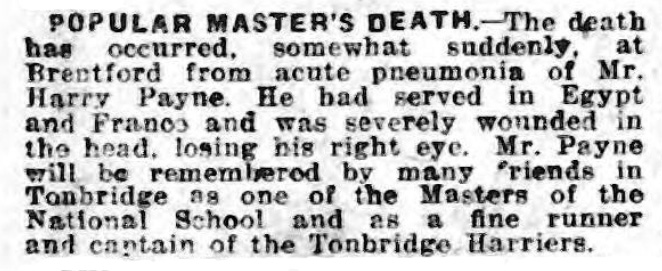Harry James Payne
December 1875 – 22nd February 1919
Private Harry James Payne, 4871 (later 241365) of the 8th (Imperial Service) Battalion, The Duke of Cambridge‘s Own (Middlesex) Regiment attached 1st/16th London Regiment, died of illness in Brentford, Middlesex on 22nd February, 1919.
Harry’s Family
James, Harry’s father, was born in Croughton, Northants, in 1845. He was the son of Mary Payne (born 1812 in Croughton). Today, Mary would simply be known as a single parent but in the late 19th Century James would have been termed illegitimate, or a bastard, and would have carried the stigma attached to those terms. His older sister Jane was in the same situation: both have Register of Baptism entries that list Mary as a Single woman. In 1851 Jane and James were both living with their mother in their grandparents’ house.1
James is described in the 1861 Census as an Agricultural Labourer, but thereafter all five censuses record him as a Domestic Butler. He married Elizabeth (née Smith) on 10th August, 1875 in Piddington, Northants, where Elizabeth was born and lived.2
Harry was born five months after the wedding, in December 1875. He was the eldest of the Payne children. Harry’s siblings, with years of birth are: Elizabeth M. (1878), Emily Mabel (1881), Charles Roland (1882) and Albert Thomas (1885, died in 1889 aged 4).
The record trail shows the family moved around the country, probably following James’s work:
1875 Farnborough, Hampshire (Marriage Certificate)
1875 Merthyr Tydfil, Glamorgan, Wales (Harry’s birth)
1878 Merthyr Tydfil (Elizabeth’s birth)
1881 Cotesbach, Leicestershire (Census and Emily’s birth)
1882 Wootton Wawen, Warwickshire (Charles’ birth)
1885 Esher, Surrey (Albert’s birth)
1901 Family at Esher, Surrey; James at Guildford, Surrey (Censuses)
1911 Esher, Surrey (Census)
Because of this mobility, it is difficult to know anything about Harry’s schooling. The fact that he became a teacher means that he must have done well at school, which is a testament in itself when set against the backdrop of such a disrupted education.
There were two main ways to enter the teaching profession for Harry, both of which would demand that he achieved high standards not only in learning but in attitude, moral standing and personal discipline.
The first, and probably most common, path was to be offered a place by the pupil’s elementary school to stay on after the completion of education and become a Pupil-Teacher. This was effectively an apprenticeship where the pupil, aged around 15, would learn alongside the class teacher. She or he would also receive tuition and training before and after the school day by the school’s head teacher. Often the Pupil-Teacher would seek a move into an Assistant Teacher post, possibly at another school, before moving on to train at college. Places at college were limited and performance in the necessary scholarship examinations had to be successful, often against stiff competition.
Another route was, on satisfactory completion of elementary education, to move to further learning at a grammar school. At the completion of secondary education, the student would then sit entrance examinations and, if successful, move on to training college. Often a grammar school place would require fees to be paid and so this was not possible to aspiring teachers from poor backgrounds.
Which route Harry took is impossible to know with the available evidence. The data in records is difficult to interpret. We know from an obituary3 that he taught, at some unspecified time, in the National School at Tonbridge, Kent. Since his time after training college is accounted for elsewhere, the Tonbridge teaching must have been before training. Unfortunately, the Census record provides us with no clue as to where Harry was living. As an independent adult, he appears to have had the habit of returning to the family home in the school Easter holidays. The national census always takes place on the first Sunday of April and this almost always coincides with the Easter break. He therefore is recorded at Esher but must have been living elsewhere.
The two options would have him as a Pupil-Teacher, or at Grammar School, in Esher until around 1894. He then probably taught as an assistant teacher at Tonbridge from that time, before moving to teach in Brentford in the early 1900s.4
We know from news articles from this time and later, that Harry was a very able athlete, with many references to his ability: particularly in running (mainly sprints), but also in cycling, swimming and rowing. He was a member of Tonbridge Athletic Club, Tonbridge Harriers, and Tonbridge Invicta Cycling Club.5 Two other Paynes appear in the sporting lists from Tonbridge but no relationship has been found connecting these with Harry’s family.
Student Life
Winchester Training College, 1902-1904
Formal training at an authorised institution was required before Harry could become a Certificated Teacher. For this he headed to Winchester Training College which was run by the Church of England. The curriculum was broad, the expected standards high, and study was mixed with practical application through students spending classroom time in one of the Practising Schools. Further variety came from sports being allocated time in the very busy daily timetable, socials, debates, and musical concerts. There was a military aspect to college life, too; all students joined the Volunteer Force—the 1st Hants Rifle Corps.
With such a sporting background, it should come as no surprise to find Harry’s abilities reflected in the pages of the student publication, The Wintonian. In the 1903 May/June issue, Harry’s selection for the Juniors6 Cricket team features. The following academic year, he is to be found playing for the Seniors. He represented the Seniors in the annual Juniors versus Seniors Cricket Match at Bar End7 (see photo below” Harry is in whites, rightmost in back row). Harry also represented the England’ side in the annual Hampshire’ versus England’ football match, again played at Bar End. Finally, from the 1904 annals, In May, Mr Payne was congratulated on his appointment as captain of The Winchester Training College Harriers Club.’
At the end of Harry’s course, the college records tell us that he took up a teaching post at Rothschild School, Brentford, Middlesex. In fact, as already noted, he had already been teaching there.
Teaching
Although formal training had been successfully completed, the final step towards certification was to teach satisfactorily for two years in the same school.
The Rothschild School (pictured right) was started in 1834, and in 1859 the foundation stone of the present building was laid by Miss Evelina de Rothschild’.8 The building and financing of the school was a family response to the terrible deprivation in Brentford, which adjoined their home at Gunnersbury Park.
At the 1906 Prize Giving, presided over by Banker Leopold de Rothschild,9 the breadth of subjects can be seen in the special prizes awarded: Field botany, Map drawing, French, Arithmetic, Recitation, History, Composition, Music, Geography, General excellence, Handwriting, Conduct, Composition, and Drawing and brushwork. The school was structured in Standards I to VII. Standard I was 7-8 year-olds, and VII was 13-14 year-olds. It wasn’t unusual for children to be kept back if the weren’t progressing, or accelerated if they were gifted.
Rothschild School Swimming Team, 1906. The master on the left is presumed to be Harry Payne. Mr Harry Payne, second master of the Rothschild School, Brentford A keen swimmer, he trained the school team, winners of the Town Challenge Cup for seven consecutive years.’ The Sportsman, February 26th, 1919
Harry taught at the school past the outbreak of war until, on 7th June, 1915, he walked through the doors of the HQ drill hall of the 8th Middlesex Regiment at Treaty Lodge, 202 Hanworth Road, Hounslow. The Middlesex Chronicle of Saturday, June 12th, 1915 reports
Mr. Harry Payne, for many years an assistant master at the Rothschild School, has enlisted in the 4/8th Middlesex.
His Medical Inspection Report on Enlistment tells us that he was 5ft. 8¾in. tall, with a 36in. chest, perfect vision, an upper plate containing 8 teeth and good physical development. Other Army records also tell us that he had a fair complexion, and brown hair and eyes.
At War
The full title of Harry’s unit was 4th/8th (Imperial Service) Battalion, The Duke of Cambridge’s Own (Middlesex) Regiment Territorial Force. The 4th/8th was responsible for recruiting, enlistment and basic training. His address at the time was 27 Whitestile Road, Brentford, Middlesex. He listed his Next of Kin as his father James Payne of Holme Lodge, Esher, Surrey.
Harry was old for Army service: 39 years and 6 months. His papers confirm that while at College he had served before as a Rifleman with the 1st Volunteer Battalion of the Hampshire Regiment.
Although enlisted in the 4th/8th Battalion, on the 18th July he embarked for Gibraltar where he joined the 2nd/8th Battalion, who had been stationed there since February 1915. His time on the Rock was not long. Leaving there on the 23rd August, he landed in Alexandria, Egypt, eight days later, as part of the Mediterranean Expeditionary Force.
The Battalion served as part of the Western Frontier Force, joining Italian troops in response to the Senussi Uprising. At the instigation of the Ottoman/German alliance, the Senussi”Libyan nomads”had declared jihad and had launched an attack from the West on British-occupied Egypt. The purpose of this was to divert British forces away from Suez”an area the Ottomans were attacking from the North and East. Harry would have been involved in the fighting along the Mediterranean Coast which culminated on February 26th, 1916, in the Action of Agagia, 220 miles west of Alexandria. The Senussi forces were routed and lost Egyptian territory secured once more. British casualties were 184 men, with the Dorset Yeomanry suffering the worst as they attacked the retreating enemy.
On May 7th, the Battalion left Egypt and arrived at Marseilles eight days later. There they spent time in quarantine for typhus fever. The men were bound for the Western Front and arrived in Rouen where the Battalion was disbanded and men dispersed to other battalions. Harry was allocated to the 1st/8th Battalion and then attached to the 1st/16th Battalion London Regiment.
Harry joined the new unit in July at a time of great need. They had just suffered terrible losses in attacks at Hébuterne, part of the Battle of the Somme, and the Somme was to be Harry’s world for the next three months.
It was a very hot summer and the Battalion’s War Diary shows that through the month of August”time given over mainly to improving trenches and defences”casualties through sickness far outweighed the few who were casualties from enemy action.
September arrived, cold and wet. Harry’s unit were moved numerous times in the first few days until they reached trenches just north of Maricourt, near Faviere Wood, where it was thought German troop numbers were building. An attack on the wood had been ordered. Harry was fortunate to come through this as casualties were very high. The writer of the Battalion War Diary is more trenchant than most and this comes through in the summary of the action:
From start to finish we had, as it turned out, no chance. Ordered to attack from a wood we had never been in before on a black dark night and on to a position we were unable to properly locate, and then owing to the breakdown of communication without the artillery barrage. And again after some 14 hours exceedingly heavy shelling being sent to it again to bomb up a trench, which as a trench, hardly existed, with hardly any trained bombers to lead the attack, it is no wonder that both the attacks failed.’
Another attack took place on the 18th at Bouleaux Wood, with more losses. The Battalion was finally relieved on the 20th. After 10 days recovery and reorganisation, they would once more be back in the thick of things. Of the 950 men in the Battalion at the start of September, only 379 would still be there by the end of it. By September 30th new men had been brought in and the Battalion was back up to full numerical strength when they were moved back into the front line, east of Morval.
On 1st October, the unit were ordered to patrol in no-man’s land to gain some insight into a trench that was to be the objective in an advance. Again the forthrightness comes through:
The enemy trench which was our objective was a half-dug trench marked on a map but which was not continuous and in point of fact was undistinguishable, at any rate, in places, as a trench and the patrol undoubtedly overshot its mark and fetched up against an occupied enemy trench further away Had we had any opportunity of reconnoitring our own front or even of studying it ourselves on aeroplane photographs, the sacrifice of a good officer10 might have been avoided.’
There followed another respite as the men were relieved of front-line duty on October 3rd and moved back, but it was short-lived. On the 7th at 8am they were marched up to trenches east of Trones Wood and moved again at 7.30pm to trenches just south of Ginchy. No details are given but sometime on that day Harry received a gunshot wound to his right eye.
Wounded Allied soldiers lie on stretchers near the village of Ginchy, waiting for evacuation. Daily Herald Archive/SSPL/Getty Images
Harry was evacuated from France to Colchester General Hospital, where he arrived 9 days after being wounded. He underwent an enucleation (eyeball removal) procedure. There was damage to the orbit too. He was in Colchester for five weeks before being transferred to the Red Cross Hospital at Ardleigh, Essex, for a further seven weeks. He was then transferred on 5th January 1917 to the County of London War Hospital at Epsom, as an outpatient, where he had an artificial eye fitted.
Harry’s discharge from the Army came on 5th September, 1917 on grounds that his eyesight was 50% or less. His character is described as Very Good and he was awarded the 1914“1915 Star, The British War Medal and the Victory Medal”all of these decorations being for service rather than notable gallantry. Harry was also awarded the Silver War Badge, which was issued to all those who had been wounded and were now discharged from the services. It was awarded to Harry on the 21st September 1917. The badge was worn on civilian clothes pinned to the right breast. The badge was first issued in September 1916 and amongst other things was intended to deter young women mistakenly handing out White Feathers to wounded ex-servicemen in civilian clothes. One would have thought that his facial disfigurement made such deterrent unnecessary. His final award was the Kings Certificate’, made to him on the 29th November, 1918. This was presented to all men and women who had been disabled during their service in the Great War. After discharge from military service he would have been granted a disability pension and at some stage he would have been made a final award for the rest of his life.
Harry returned to teaching at Rothschild School, living in Brentford”a brave step for someone with limited sight and facial disfigurement. His return to teaching would be short. On Saturday, 22nd February, 1919, Harry died at Brentford of influenza, aged 43.11 His mother and father took his body home and he was buried at Esher on the following Friday.
It remains a puzzle as to why Harry is included on the College Roll of Honour. Asking this question does no disservice to him, for his desire to serve King and Country, his bravery and sacrifice stand unquestioned. However, it was usual to restrict inclusion on memorials to those who died while still in military service.
It is strange to reflect that another of the College War Dead, Captain Frederick Bishop M.C., died the day before Harry. Also a victim of influenza, he died in an officers’ hospital in Marylebone, only eight miles from Harry. Unlike Harry, he was still in active service. Could it be that the seeming injustice was too much to tolerate: of denying the man who had suffered such a life-changing injury, while admitting the other who died in the same way at the same time in the same place?
Researcher and Author: John Vickers
Footnotes
[1] In 1841, the infant Jane was living in the same arrangement. In that census their surname was spelled Pain’
[2] She was born in Hackleton, a hamlet that abuts Piddington. Hackleton has no Parish Church.
[3] The Marriage Certificate contains an anomaly: James’ father is listed as Henry Payne, a Servant by occupation. The possibilities are either improbable, shocking, or illegal: after James’s birth, his single mother may have married someone with the same surname; his father could have been someone in his own family; or a name was invented to cover up the illegitimacy of his birth. All other details would strongly suggest it is highly probable that this is the correct document for their marriage.
[4] We know of the existence of the fifth child from the 1911 Census which lists the number of children born to the marriage, the number still alive, and the number dead.
[5] The Courier, February 28th, 1919. It goes under the title Popular Master’s Death’
[6] He is recorded as a Brentford resident in 1903 while at Winchester Training College, probably at the school to which he returned after College: The Rothschild School. (Source: London Daily News – Monday 05 October 190, where he is reported as a Brentford resident who made a gift of £1 towards the relief of the Macedonian Famine). Returning to the same school after training is not uncommon.
[7] Maidstone and Kentish Journal, Thursday 28th May, 1896; The Courier, February 28th, 1919; The Sporting Life, Wednesday 13th April, 1898
[8] First-Year students were known as Juniors, Second-Years as Seniors
[9] Bar End is still used as the College (now University) sports fields, on the East of the City. It is approximately 1½ miles from the College. At this time the College hired the playing fields when playing visiting teams and for important matches. It was purchased by the College in 1934. (Source: A History of King Alfred’s College, Winchester 1840-1980 by Martial Rose, pages 71, 84). Football and other games were usually played on the dytche, a level playing field on the college campus itself.
[10] This and details of the prizes awarded (below) are from The Brentford and Chiswick Times, 30th March, 1906. See http://www.bhsproject.co.uk/news_rschool_1906.shtml for a transcription
[11] Head of N M Rothschild & Sons in London, the family’s world-famous banking business
[12] Battalion casualties were 41 Other Ranks on the day.
[13] Late 1918 and early 1919 were the third and last peak of the Spanish Flu pandemic.
Sources
Ancestry (2018). Home page. [online] Available at: www.ancestry.co.uk [Accessed 2018].
Brentford High Street Project (2011). Brentford Rothschild School, 1906. [online] Available at: http://www.bhsproject.co.uk/photo_rothschildsch1906_ah.shtml [Accessed 2018].
Brentford High Street Project (2011). Rothschild School Prize Giving, 1906. [online] Available at: http://www.bhsproject.co.uk/news_rschool_1906.shtml [Accessed 2018].
British Newspaper Archive (2018). The Brentford and Chiswick Times, 30th March, 1906. [online] Available at: www.britishnewspaperarchive.co.uk [Accessed 2018].
British Newspaper Archive (2018). The Courier, February 28th, 1919. [online] Available at: www.britishnewspaperarchive.co.uk [Accessed 2018].
British Newspaper Archive (2018). Maidstone and Kentish Journal, Thursday 28th May, 1896. [online] Available at: www.britishnewspaperarchive.co.uk [Accessed 2018].
British Newspaper Archive (2018). Maidstone and Kentish Journal, Thursday 1st June, 1899. [online] Available at: www.britishnewspaperarchive.co.uk [Accessed 2018].
British Newspaper Archive (2018). The Sporting Life, Wednesday 13th April, 1898. [online] Available at: www.britishnewspaperarchive.co.uk [Accessed 2018].
British Newspaper Archive (2018). The Sportsman, February 26th, 1919. [online] Available at: www.britishnewspaperarchive.co.uk [Accessed 2018].
Commonwealth War Graves Commission, (2018). Home page. [online] Available at www.cwgc.org/ [Accessed 2018].
National Union of Teachers. (1920). War Record 1914“1919. A Short Account of Duty and Work Accomplished During the War. London: NUT.
Rose, M. (1981). A history of King Alfred’s College, Winchester 1840-1980. London: Phillimore.
Vickers, J. University of Winchester Chapel Memorial Rail image.
| University of Winchester Archive “ Hampshire Record Office | ||
| Reference code | Record | |
| 47M91W/ | P2/4 | The Wintonian 1899-1900 |
| 47M91W/ | P2/5 | The Wintonian 1901-1902 |
| 47M91W/ | P2/6 | The Wintonian 1903-1904 |
| 47M91W/ | P2/7 | The Wintonian 1904-1906 |
| 47M91W/ | P2/8 | The Wintonian 1905-1907 |
| 47M91W/ | P2/10 | The Wintonian 1908-1910 |
| 47M91W/ | P2/11 | The Wintonian 1910-1914 |
| 47M91W/ | P2/12 | The Wintonian 1920-1925 |
| 47M91W/ | D1/2 | The Student Register |
| 47M91W/ | S5//5/10 | Photograph of 5 alumni in Mesopotamia |
| 47M91W/ | Q3/6 | A Khaki Diary |
| 47M91W/ | B1/2 | Reports of Training College 1913-1914 |
| 47M91W/ | Q1/5 | Report and Balance Sheets 1904- 1949 |
| 47M91W/ | R2/5 | History of the Volunteers Company 1910 |
| 47M91W/ | L1/2 | College Rules 1920 |
| Hampshire Record Office archive | ||
| 71M88W/6 | List of Prisoners at Kut | |
| 55M81W/PJ1 | Managers’ Minute Book 1876-1903 | |
| All material referenced as 47M91W/ is the copyright of The University of Winchester. Permission to reproduce photographs and other material for this narrative has been agreed by the University and Hampshire Record Office. | ||


